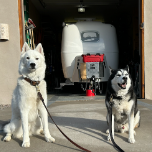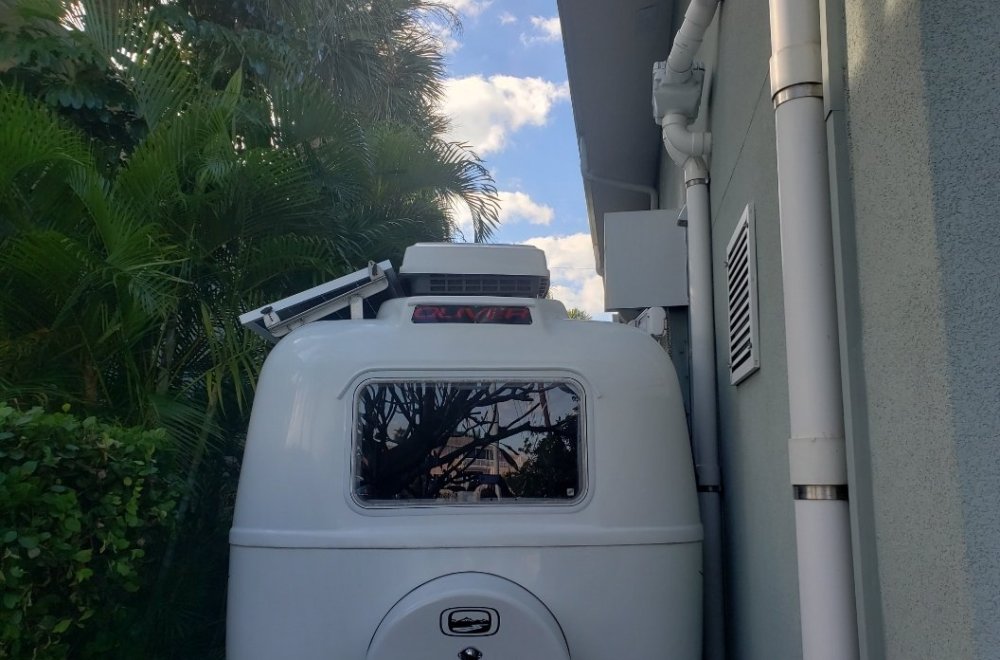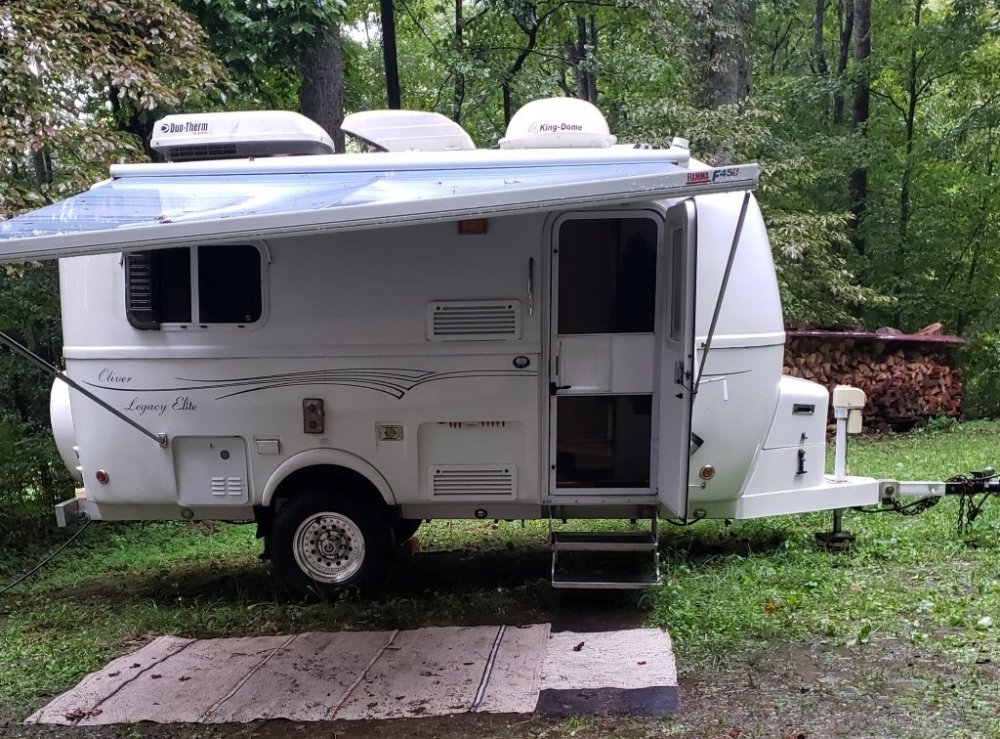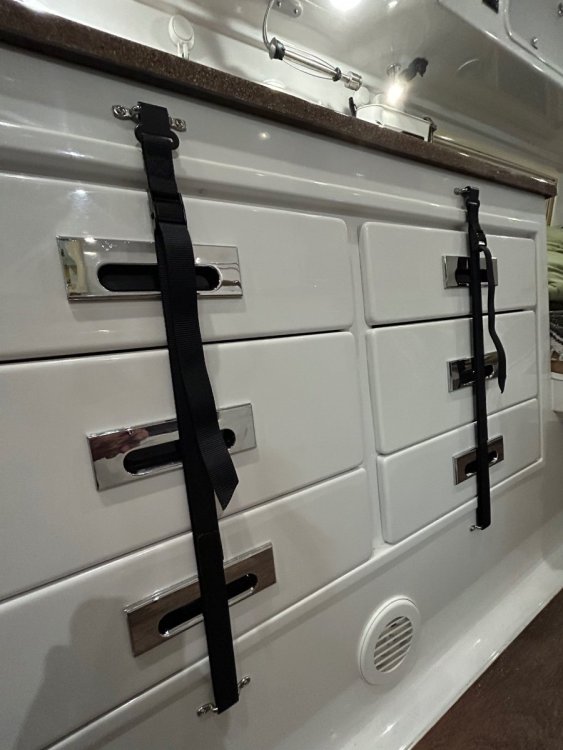-
Posts
1,670 -
Joined
-
Last visited
-
Days Won
68
Posts posted by MAX Burner
-
-
2 hours ago, ScubaRx said:
I'm all about overkill, but a combination of two surge protectors (Surge/Only Portable at the pedestal and a Surge/EMS inside of your RV) will not interfere with each other, and will basically double your Joules of surge and spike voltage protection. And the inexpensive (under $100) portable Surge/Only protector on the pedestal becomes the sacrificial element that can be destroyed by a really big lightning hit in the area, or stolen by a thief looking to liberate you from your more expensive Surge/EMS protector.
Totally concur, 100%. Maybe a bit off the topic of this thread, but...
We carry and use an inexpensive portable surge protector for all the same reasons @ScubaRx describes - plus connecting it first to the power pedestal will give you a reading of the nature of the power being provided at that point of usage. We recently had a reversed neutral readout - it stopped us from connecting the Ollie and we notified the RV park office attendant. Apparently, recent maintenance on the pedestal left this condition. It may not have caused damage by proceeding to connect, and the internal Surge/EMS would have likely saved the day - but why gamble on it?
-
 2
2
-
-
We're used to rotating our spare into the running gear sneakers with our old "ASs", thinking that it would make the 5-tire set last up to 20% longer. Obviously, on replacement you're paying for a 5-tire set instead of only 4. Where we live in the Great Southwest, the heat still degrades the spare even though it's covered from harmful UV under the spare cover - so refreshing the spare at "new tire time" makes sense to us. Counting on having a 5+ year old dusty spare perform safely when we need it most might be sketchy, IMO. We have a fresh set Cooper Discoverer HT3's on our 16" wheels and will continue to rotate the 5th tire into the mix - a little bit of a PIMA, but worth the peace of mind. We're happy that Hull 226's spare cover fits over our size sneakers!
Not good to be chintzy with running gear...
Cheers!
-
 1
1
-
-
-
2 hours ago, SeaDawg said:
Yes. We move the front at an angle.
Thanks. It's great that you can access inside - even if its just to hang out and have a cold one!
-
 1
1
-
-
15 hours ago, SeaDawg said:
Almost 16 years, @Patriot. We brought it home, February, 2008.
I'll look for a few more. You can see my trailer in every update post we do.
These are from 2020, I think.
You can see the yellowed jack head. My bad. We should have covered it.
So, @SeaDawg - can y'all still shimmy into the main hatch when there's a need to play inside your Ollie when docked along side the house? Just curious...
-
10 hours ago, rideandfly said:
Mushroom style tire plugs
These work great! Used them on our dual-sport motorcycle when even a "pinch flat" could be repaired well enough to get back to civilization! Highly recommend having this small/tidy as part of a standard load-out kit for anyone traveling on inflatable running gear, IMO.
-
 1
1
-
-
16 hours ago, ScubaRx said:
John Davies was not satisfied carrying a small tire as a spare and simply removed the tire cover and replaced the tire with a standard size leaving it uncovered.
I'm thinking that @John E Davies actually upgraded all of his tires to a larger/taller size and wanted the same size for his spare. The size of that tire couldn't fit inside the tire cover - so he wrapped up the tire cover and stored it in his shop, but I could be mistaken - I've slept since I read that thread. HA!
-
 1
1
-
 1
1
-
-
1 hour ago, Brian and Brandelyne said:
Lithionics batteries have ON/OFF switches so you can turn the battery itself OFF for storage. I think that is a nice feature and it's good when you want to do work around the battery.
Concur, 100%.
I'm thinking, as a "Battle Born Guy", that one would achieve the same effect by having a master battery cut-off switch inside the battery compartment, labeled accordingly, specifically for first responders in the case of a fire and the need for securing electrical power to the rig.
-
 2
2
-
-
@mossemi: Yes, the orange and black release handle…
-
5 minutes ago, John E Davies said:
As a final note, with this knowledge you could wreak havoc on your neighbors if you were feeling mischievous!
HA! Good one! 🤣
-
 1
1
-
-
11 hours ago, Boudicca908 said:
My friend taught me her brother's "fix" for re-installing screws into small holes in wood when they basically won't take a bite: put wooden toothpicks and wood glue into the hole, let them set, cut the exposed ends off flush, and then screw back together. So far, so good.
Very ironic/timely comment here.
A few months ago, we experienced the launching of our middle right galley drawer onto the deck after perhaps taking a few windy curves a bit too fast and having WAY too many cooking pots/pans inside of it. The forces ripped the locking mechanisms from their mounting positions underneath the drawer held there by two (IMO) very small wood screws.
The "toothpick temporary" fix was executed in situ while camping that afternoon. Until just yesterday, we removed all the drawers to inspect for potential water damage as suggested by another forum thread, only to find that the toothpick fix was not holding. So we removed the short factory-installed drawer screws and replaced them with 3/4" wood screws that reach into the drawer fronts.
It's suspected that the factory builds the drawers, installs the rail hardware before they attach the drawer fronts - makes sense to use shorter screws that don't penetrate the drawer box. But who knows? The longer attachment screws are just another effort to achieve a "peace of mind" knowing they'll last a bit longer. IMO, the longer screws with the Raingly Footman Loops/straps make the drawer system more bomb-proof when towing.
My $0.02.
-
 3
3
-
-
-
@Steve Morris: Steve, nice looking set-up for the bikes, brother! Really like the license plate mount and the hard point tie-down through the spare tire cover... Great idea.
Our's is slightly different, but what we found very helpful during our road trip this week (in reducing the jostling), was adding 2 tie-down straps at both ends of the top tubes and the other ends (left and right) back down to the ends of the square tubing.
No issues... Rock-Solid!
-
 3
3
-
-
@JRK: Hey, brother - really sorry to hear about the issues with your rig. Your frustration is noted.
Sometimes these toys of our's are a kin to eating the proverbial elephant - it can be done, but it takes one bite at a time.
Probably preaching to the choir here, but preparing and studying a comprehensive and prioritized list of "squawks" or discrepancies sometimes helps us get our head around the big picture. Then making a maintenance schedule or just a "punch list" helps even more - after some time and effort, the list gets smaller. A few other gripes may pop up in the meantime which get added to the others. This process clearly doesn't reach completion over night and takes patience - in our case, the end of the "to-do list" will likely never happen. So be it.
Totally understand that if an OTT owner doesn't have the confidence in their rig that it'll perform safely while being towed and systems operate correctly when camping,then trips get cancelled, it'll likely sit in storage - then eventually get sold. However, many of the fixes for the annoying issues described above are addressed by others on the forum, IMO.
FYI, We have yet to encounter a discrepancy that either a call to the OTT factory or a shout-out to the forum that couldn't be solved - there have been dozens.
For example here's a couple ideas for keeping drawers closed while towing:
1. Search for this title - this fix uses bungees and stainless steel tie-downs:
"Kitchen drawers. - keeping closed"
2. This one uses Raingly tie-downs and nylon straps:
Enough "apple pie and Motherhood"...
Hang in there - you'll soon see the light at the end of the tunnel; it might even be a rear Oliver sign!
-
 3
3
-
-
...follow-up info: @Gliddenwoods: We installed that mod 3 days before leaving on the road trip we're currently on now. After the first leg, about 275 miles, checking the pantry compartment sliding top a few times - no issues. The "soft-close" slides hold fast.
-
On 7/30/2023 at 6:04 PM, Patriot said:
We got a little creative and made a place where we can enjoy a campfire, tell a few tales,
and even a few true camping stories.
Looks like a nice set-up you have there, @Patriot...
Nice place for telling "Fairy Tales" and "Sea Stories" (You know what the difference between the two are, right?)
-
 1
1
-
-
...as a follow-up: In general, the Berkey gives potable water from the OTT fresh water tank - even if sanitized, the fresh tank system could become slightly contaminated between trips depending on the nature of the water after topping-off. So, the Travel Berk gives us the peace of mind by having a final layer of filtration before we consume Casablanca water when boon docking. It also allows us to avoid using bottled water and having to deal with the plastic empties.
-
 2
2
-
-
15 hours ago, SeaDawg said:
@MAX Burner, did the stand come with the Berkey travel?
The travel stand is extra. Makes it so you can put it deeper onto a platform. We always buy our Berkey gear around the holidays when the site discounts everything - it was $20 bucks for the stand. We got our first Royal Berkey back in '07, lov'n it still....
-
 2
2
-
-
Hey, Bobby! Welcome aboard!
Congrats on your new Ollie and for your very first post on the forum. This is a wonderful on-line forum and the more you visit the more you'll learn about the complexities and nuances of the OTT. Jason and his team are first class all the way - we're not surprised to hear about your experience getting your furnace operational, thanks for sharing that with the group. It's really like having an extended family of like-minded folks to bounce ideas off and solve challenges.
If anything comes up - between calling the factory team and probing this site, you'll get solutions - every time.
Take care and enjoy making new memories out on the road!
-
 1
1
-
-
2 minutes ago, Sparklite said:
It was designed for boats, and don't think they anticipated snow and ice on boating trips
Roger that!
-
On 7/24/2023 at 5:42 PM, Caddymv said:
Acadia seashore campground. Just beautiful
Sweet - like candy! Enjoy!
-
FYI: Our shower's converted to the Scandvik mixing valves mounted on the sink stand bulkhead available from, you guessed it, Amazon:
Like @SeaDawg, we love Scandvik products...
-
 3
3
-
-
@Sully: How's the Q7 behaving? We're interested in them as another TV.
-
 1
1
-
-
15 hours ago, jd1923 said:
I went with 6" extensions, since I really dislike craning my neck to reach under!
Great mod, thanks for sharing!
















Upgrade outside shower
in Towing an Oliver
Posted
Concur w/@SeaDawg: we've been using the Ecotemp at our dry cabin in CO near Mogote since 2008 - our's runs on a pack of D-cell batts, you definitely need to remove them as a part of your winterizing checklist. We built a vented plywood box and mounted it on the cabin for outside showers - 100's of showers, indeed! Good product for sure.